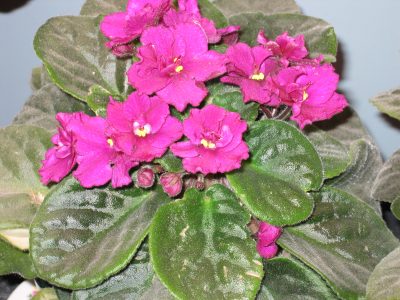Alluring African Violets Chosen as 2024 Houseplant of the Year
By Dawn Pettinelli, UConn Home & Garden Education Center
This last decade or so has seen a burgeoning interest in houseplants. While this has led to the introduction of some new and exciting species, classic stalwarts are still in demand as evidenced by the National Garden Bureau naming African violet the 2024 Houseplant of the Year. They are from Africa, as their name implies, but they are not related to the violets we commonly encounter in our gardens. These plants were discovered in the mountainous regions of Tanzania and Kenya where they grew in shady, rocky locations.
The first person to successfully send plant material back to Germany where it eventually reached the Royal Botanic Gardens at Herrenhausen was Captain Baron Walter Saint Paul in 1892. This new species of plant was placed in the Gesneriad family and given the Latin name, Saintpaulia ionantha. A number of additional species were described over the next half century. More recently, after DNA analysis, African violets were put in the genus, Streptocarpus.
Regardless of their classification, African violets are endearing plants showering their caretakers with an almost continuous parade of blossoms if properly taken care of. Maybe the most difficult part of growing African violets is deciding which ones to grow. They can be found as miniature, standard, and trailing varieties and there are thousands of cultivars. In fact, the African Violet Society of America (www.africanvioletsocietyofamerica.org) has a Master Variety List of over 16,000 recorded species and cultivars.
Flower color ranges from white to pink, purple, blue, violet as well as bicolored cultivars. They can be single, double or semi-double, ruffled or picoteed. Leaves can be a handsome green, some with burgundy overtones while others can be variegated or mosaic. Whichever type or cultivar of African violet you choose, care is similar.

The proper amount of light is key to good flowering. Plants need lots of bright indirect light. East windows are usually ideal as they get morning sun. If only a west or south facing window is available, filter the light with sheers. African violets do exceptionally well under fluorescent or LED lights. Consider artificial lighting if natural light is limited.
Temperature is also important. African violets mostly thrive in the same temperatures we do, around 65 to 70 degrees F. Place them where nighttime temperatures do not drop below 55 F. This is more likely to be a problem during cold winters when plants are left too close to windows. Often exposure to cold results in the plant starting to wilt. Daytime highs ideally should not exceed 75 F.
When watering your African violets, avoid getting water on the hairy leaves as this may cause spotting. Many African violet enthusiasts choose to water from the bottom. Plants can be grown in special ceramic African violet pots where a well is filled with water, and it keeps the root ball just moistened enough. Plants can also be watered using a watering can with a long narrow spout so water can be directed at the potting mix and not land on the leaves. The potting mix should stay moderately moist at all times but should not be saturated. If watering from the top and excess water drains into a saucer, be sure to empty it. Soggy soils promote crown and stem rots.
African violets like a very well-draining potting mix rich in organic matter with an acidic pH. One can purchase specialty mixes for African violets, or a standard soilless commercial potting mix will do. While plants do need to be fertilized during their period of active growth, which is usually spring and summer, note if when repotting the mix you are using already contains fertilizer. If it does, don’t start fertilizing until plants start looking a little light in color. If no fertilizer was added to the potting mix, you can use a half strength liquid fertilizer every 2 weeks or so from mid-March until about mid-October.
Plants bloom best when slightly pot-bound. Often the plant can be lifted once a year and then groomed and reset back into its original pot with some fresh potting media or in a slightly larger one. Remove spent flowers to encourage more flower buds to form.
Sometimes cyclamen mites, spider mites or root rots can be a problem so pay attention to your plants and see that they are receiving the proper care. Always isolate new plants for 30 days before introducing to your collection.
For questions about African violets or if you have any other gardening questions, contact the UConn Home & Garden Education at (877) 486-6271 or www.homegarden.cahnr,uconn.edu or your local Cooperative Extension Center.